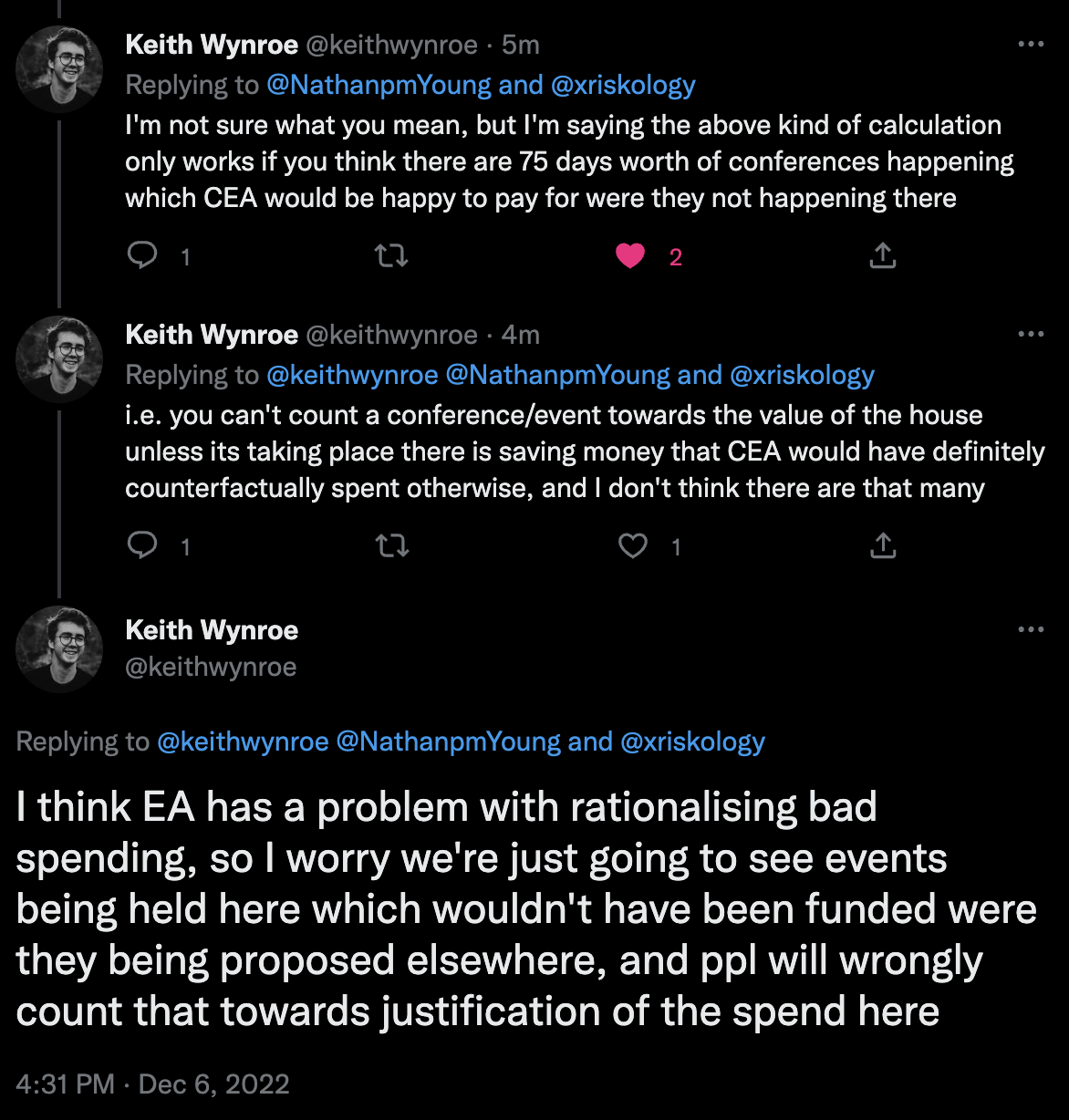Edit to add (9/1/2023): This post was written quickly and I judged things prematurely. I also regret not reaching out to Effective Ventures before posting it. Regarding my current opinion on the Abbey: I don't have anything really useful to say that isn't mentioned by others. The goal of this post was to ask a question and gather information, mostly because I was very surprised. I don't have a strong opinion on the purchase anymore and the ones I have are with high uncertainty. More thoughts in my case for transparent spending.
Yesterday morning I woke up and saw this tweet by Émile Torres: https://twitter.com/xriskology/status/1599511179738505216
I was shocked, angry and upset at first. Especially since it appears that the estate was for sale last year for 15 million pounds: https://twitter.com/RhiannonDauster/status/1599539148565934086
I'm not a big fan of Émile's writing and how they often misrepresent the EA movement. But that's not what this question is about, because they do raise a good point here: Why did CEA buy this property? My trust in CEA has been a bit shaky lately, and this doesn't help.
Apparently it was already mentioned in the New Yorker piece: https://www.newyorker.com/magazine/2022/08/15/the-reluctant-prophet-of-effective-altruism#:~:text=Last year%2C the Centre for Effective Altruism bought Wytham Abbey%2C a palatial estate near Oxford%2C built in 1480. Money%2C which no longer seemed an object%2C was increasingly being reinvested in the community itself.
"Last year, the Centre for Effective Altruism bought Wytham Abbey, a palatial estate near Oxford, built in 1480. Money, which no longer seemed an object, was increasingly being reinvested in the community itself."
For some reason I glanced over it at the time, or I just didn't realize the seriousness of it.
Upon more research, I came across this comment by Shakeel Hashim: "In April, Effective Ventures purchased Wytham Abbey and some land around it (but <1% of the 2,500 acre estate you're suggesting). Wytham is in the process of being established as a convening centre to run workshops and meetings that bring together people to think seriously about how to address important problems in the world. The vision is modelled on traditional specialist conference centres, e.g. Oberwolfach, The Rockefeller Foundation Bellagio Center or the Brocher Foundation.
The purchase was made from a large grant made specifically for this. There was no money from FTX or affiliated individuals or organizations." https://forum.effectivealtruism.org/posts/Et7oPMu6czhEd8ExW/why-you-re-not-hearing-as-much-from-ea-orgs-as-you-d-like?commentId=uRDZKw24mYe2NP4eq
I'm very relieved to hear money from individual donors wasn't used. And the <1% suggests 15 million pounds perhaps wasn't spent. Still, I'd love to hear and understand more about this project and why CEA thinks it's cost-effective. What is the EV calculation behind it?
Like the New Yorker piece points out, with more funding there has been a lot of spending within the movement itself. And that's fine, great even. This way more outreach can be done and the movement can grow. But we don't want to be too self-serving, and I'm scared too much of this thinking will lead to rationalizing lavish expenses (and I'm afraid this is already happening). There needs to be more transparency behind big expenses.
Edit to add: If this expense has been made a while back, why not announce it then?


Just to set some context: 15 million pounds may sound like a lot of money to young academics and researchers, or to buyers of residential real estate (e.g. typical single family homes). It may look like 'lavish spending'.
But it's really not a lot compared to typical buildings for academic departments on and around university campuses.
I've worked in a dozen universities over the last 35+ years, and we frequently see announcements of new buildings being constructed for 10-50 million dollars -- even in state universities with relatively limited budgets.
This 2016 review of building costs in higher education is slightly outdated now (given high inflation rates since then), but it reports a typical cost of $800/square feet for new academic buildings.
Consider a modest building for a medium-sized department like mine (e.g. 25 faculty, 70 grad students, 15 staff, etc.). The building (Logan Hall, UNM) is 55,000 gross square feet, so its build cost new would be about $44 million.
Costs for new building in the Oxford area are probably even higher, and greatly complicated by British zoning and building regulations within the Oxford Green Belt.
Long story short, 15 million pounds might sound like a lot for Wytham Abbey, but it's not out of line for an academic research/conference center, and it's arguably fairly cheap, given the extremely high complexity and cost of building in south-east England.
Cool, thanks for clarifying your view! To clarify, here's a version of your comment that I wouldn't have objected to at all (filling in details where I left things in square brackets):
'You're right that the building is a manor house rather than a castle, and I'm generally in favor of EAs being accurate and precise in our language. That said, I think [demographic D] will mostly not be convinced of EA's virtue by this argument, because people still think of manor houses as quite fancy. And I think it's important for EA to convince [demographic D] of our virt... (read more)